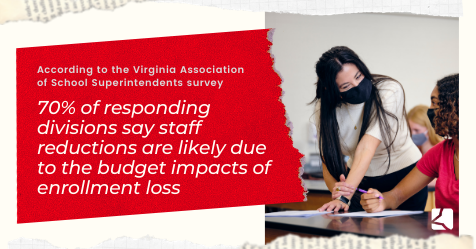October 6, 2020
Enrollment Losses Could Have Big Impacts on Schools Unless Lawmakers Take Action Now
Among the many uncertainties that schools faced going into this school year was how many students would enroll and what resources they’d have to meet student needs. Since state dollars are largely allocated on a per-student basis in Virginia, large declines in enrollment mean that schools will see a dramatic drop-off in resources – threatening teacher layoffs and further tightening school budgets. With many divisions in Virginia 100% virtual and spikes in private school applications during the summer, enrollment loss seemed likely. A survey conducted by the Virginia Association of School Superintendents (VASS) confirms that enrollment has dropped. State legislators are currently in session and can take steps to preserve resources for schools during this crisis. This can be done with language in the state budget to delay the impacts of enrollment loss until after March (as currently proposed in the House budget) or by including a “hold harmless protection” that ensures no division receives less state funding this year or next than they did in the 2019-2020 school year.
The VASS survey (responded to by 123 of Virginia’s 132 school divisions) shows that many responding divisions have experienced enrollment declines in the first weeks of the school year. In total, the survey estimates 36,500 fewer students than initially anticipated. That loss in enrollment would have a sizable impact on state funding come January when the Virginia Department of Education (VDOE) recalculates enrollment based on the new fall data. VASS estimates a state funding loss greater than $150 million for the current school year.

Schools already run on very tight budgets, with many fixed costs including building maintenance and utilities, and any budget shifts mid-year, particularly large unexpected ones, will be hard to deal with outside of painful cuts. (State funding has still not recovered from cuts made during the last recession.) And even with fewer students, the responsibilities of staff and teachers are growing in order to respond to the needs of students in this unprecedented time and work to provide a safe learning environment. The huge hit to school budgets is why 70% of responding divisions to the VASS survey say staff reductions are likely. Those layoffs mean larger class sizes for students and putting many people, from a largely female workforce, out of a job. In Virginia schools, more than 80% of teachers are women.
The state budget adopted back in March included language and funding ($3.7 million) to hold all school divisions harmless, meaning that no division would receive less state funding this year than they did in the 2019-2020 school year, regardless of enrollment changes. Unfortunately, these dollars were removed from the budget by the governor when he presented his revised budget on Aug. 18. Last week, the House and Senate approved competing revisions to the governor’s budget. Neither chamber includes language for holding school divisions harmless, yet the House does take an important step to delay enrollment declines from hitting school budgets. The House budget amendment delays adjustments to enrollment from impacting state payments to school divisions until after March. This means the General Assembly will have the opportunity in the January 2021 legislative session to take further steps and prevent these funding losses altogether. The Senate proposal includes no protections.
Budget conferees from the House and Senate are meeting this week to determine a compromise version. Typically, conferees negotiate between the chambers’ two proposals. While only a temporary fix, the House proposal to delay enrollment adjustments until after March is a significant improvement over the Senate’s alternative of no action, because it gives legislators more time to design and adopt a longer term solution. By delaying the enrollment adjustments (proposed by the House) or by holding school divisions harmless (similar to what was included back in March), school leaders will have more assurances of what state funding to expect and help them protect against layoffs and reduced services for students. These protections also won’t come at a large cost to the state, it would simply protect what’s currently being allocated. Given the many uncertainties students, families, staff, and schools are currently facing, this is one that the legislature can resolve right now.
Category:
Education
